What Happens to My Shopify Store After I Upload Acsv File
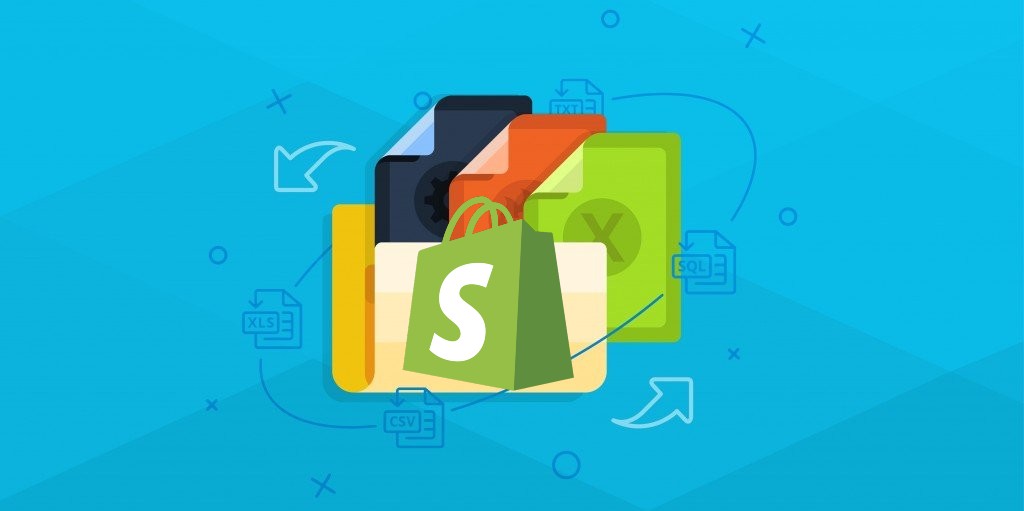
Every decent e-commerce platform offers congenital-in import and consign tools . Yet, they are usually far from being an omnipotent solution that can cope with whatsoever business requirement. In view of this, agencies create third-party solutions that close the existing gaps between the platform'south objective reality and the merchants' subjective needs. What nigh Shopify ? What data transfer solutions does information technology offer? What reliable alternatives are currently available in the ecosystem?
In this Shopify import guide , you will find out what import functionality is subconscious behind the platform and how to enhance it in the near user-friendly and at the same time powerful fashion. Let's explore the system's native capabilities showtime and and so proceed to the most powerful 3rd-political party solution that copes with any data transfer challenges and enables whatever Shopify import customizations – Firebear Improved Import & Consign App for Shopify .
Beneath, you lot will learn near the bones import capabilities of Shopify . Nosotros describe how to transfer products to your due east-commerce website using its born functionality. The commodity examines 2 dissimilar cases: importing products from another website and reimporting them within the borders of your store. In addition to that, we provide a CSV file construction required in the ecosystem. The aforementioned tutorials are available for other entities: nosotros teach how to import inventory, customers, and orders to Shopify .

(Download for Gratis)
Before going any further, we should remind you that the Firebear team has vast experience transferring data between Magento 2 and all possible external systems. Furthermore, we can also help you lot migrate to Shopify or move data betwixt your e-commerce website and external tools. Our specialists are capable of Shopify integrations of whatsoever complexity. Contact us for more detail.
Table of contents
- 1 Shopify Import Capabilities
- 1.1 How to import products to Shopify
- i.1.ane Importing products from another store
- 1.1.2 Reimporting products from Shopify
- 1.i.iii Shopify product import: CSV file format
- 1.2 How to import inventory to Shopify
- 1.2.1 Shopify inventory import: CSV file format
- 1.3 How to import customers to Shopify
- 1.iii.1 Shopify customer import: CSV file format
- 1.iv How to import orders to Shopify
- 1.1 How to import products to Shopify
- 2 Firebear Improved Import & Export App for Shopify
- 3 Shopify Import FAQ
- iii.1 Can I upload a CSV to Shopify?
- 3.2 Can you bulk upload products to Shopify?
- 3.three How do I import customers to Shopify?
- 3.4 How practice I import items into Shopify?
- 3.5 How many products tin I upload to Shopify?
- three.six How do I import a product prototype into Shopify?
Shopify Import Capabilities
Shopify lets you import several entities by default. Notwithstanding, in that location is no single interface where you tin control all data transfers. You are also bound to CSV files and cannot automate import processes. Besides, various useful data transfer features are available in Shopify Plus only. Let's have a expect at what you get.
How to import products to Shopify
Why do you demand to import products to Shopify? Firstly, because you drift from some other platform. It is the fastest way to recreate your current product catalog on a new storefront.
Secondly, yous may leverage this functionality to update your products or inventory. However, information technology is necessary to export the corresponding data to get a CSV file that reflects the current land of things. Then, you can edit it and reimport the updated data back into the system.
Bear in mind that you e'er need to back up your product information to prevent whatever data loss. For case, importing a CSV file edited in Microsoft Excel or Numbers often leads to the absent-minded product images and other issues. Therefore, it is extremely of import to create a correct copy of your catalog before applying any changes.
Importing products from another store
Permit's assume that you've exported a CSV file with products from another platform and at present need to transfer this data to Shopify. Unfortunately, yous cannot do that since the existing canvass is bundled according to the external platform's requirements. Edit information technology to match Shopify's CSV file format. Note that even a missing header leads to the import failure.
Another limitation is associated with file size. You lot cannot import more than 15MB of production data to Shopify.
As for the import process itself, it is quite simple. You only need to follow these steps:
- Become to Shopify admin -> Products -> All products and hit the Import button.
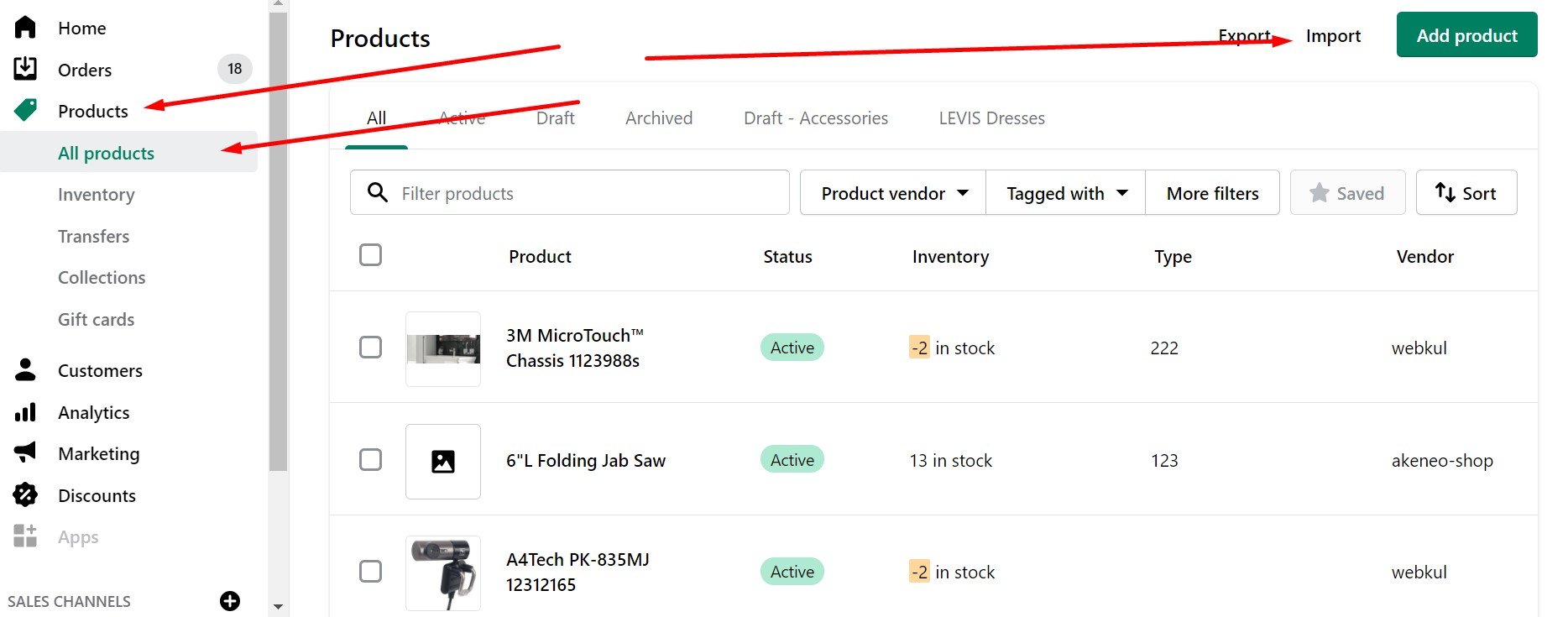
- The Import products by CSV file window displays. Click Cull File there.

- Locate your product CSV and click Open .
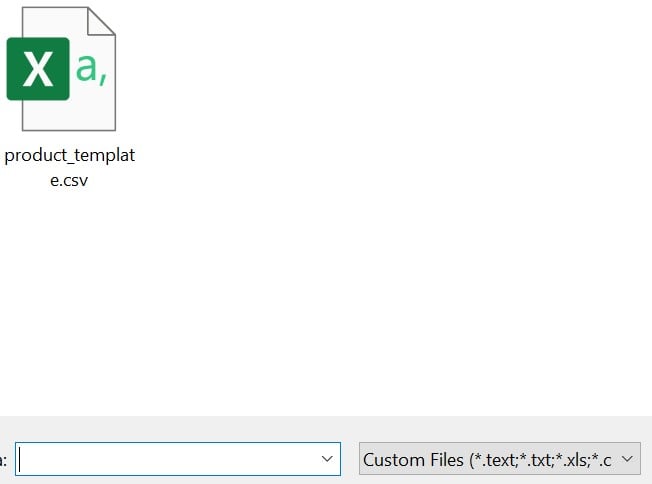
- Upload the file .
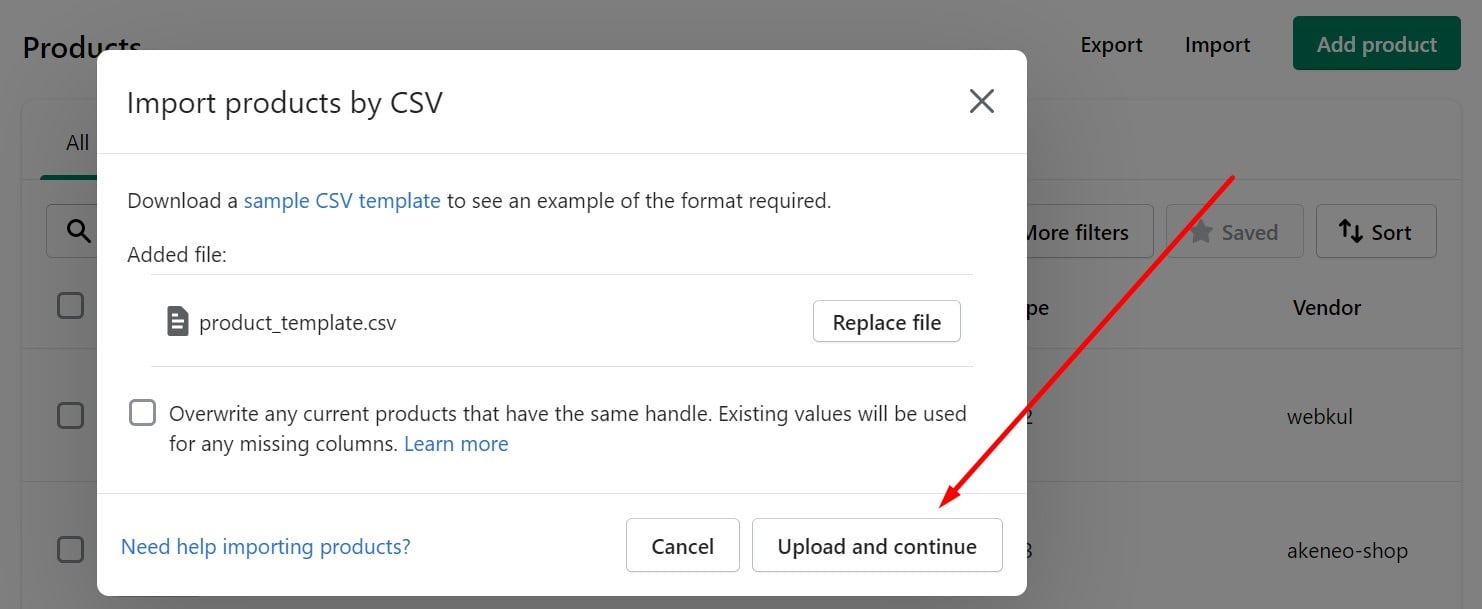
That'south it. When the process is consummate, you receive a confirmation electronic mail.
Reimporting products from Shopify
Shopify enables you to apply changes to your catalog items via CSV. Export your products, edit the CSV file and reimport information technology back into your Shopify store. Nevertheless, this method doesn't piece of work if you rely on Oberlo and other like apps to add products to your website.
You can import products to Shopify as follows:
- Go to Shopify admin -> Products -> All products and hitting the Import button.
- The Import products by CSV file window displays. Click Choose File there.
- Locate your product CSV and click Open up .
- By enabling the Overwrite any current products that take the aforementioned handle feature, you lot override the corresponding Shopify information. For columns that aren't present in the CSV file, the corresponding product information remains untouched. For instance, if you transfer items without price information, Shopify volition keep the existing values.
- Upload the file .
A confirmation email is sent upon a successful upload.
Shopify production import: CSV file format
Beneath, you tin can encounter a list that shows the structure of a typical product file supported in Shopify.
Handle. Here, you should specify unique product names using letters, dashes, and numbers. Annotation that spaces, accents, periods, and other characters are prohibited.
Information technology is also worth mentioning that Shopify uses handles in product URLs.
Besides, Shopify treats every line in the CSV file that starts with a different handle as a new product. However, you tin can use multiple lines with the same handle to add multiple images to a single production. Since this field is required, information technology cannot be blank or missing.
Title. This column contains the championship of your production — for example, Women'southward Hoodie. Since this field is required, it cannot be blank or missing.
Body (HTML). Here, you can provide the production clarification in HTML format or as plain text. This i can be blank.
Vendor. The vendor name for the product is shown hither. It should incorporate more than than two characters. The field is required but can be blank.
Type. This column displays the product type, such as Snowboard. Yous can leave information technology blank.
Tags. Here, y'all can place a comma-separated list of tags associated with the production. Add quotes around the tags if they are absent: "tag1, tag2, tag3". This one tin can exist blank.
Published. In this column, yous provide information on whether a production is published on your storefront or not:
- True – the product is published;
- FALSE – the product is hidden.
The field is required. Leaving information technology blank publishes the production.
Option1 Proper noun. Specify a product option name (Color) if an item contains options. Set it to Title for products with but ane choice. Since this field is required, it cannot be blank or missing.
Option1 Value. If a product is associated with an option, you should enter its value hither (White).
For products with only i option, prepare it to Default Championship. Likewise, note that changing data in this column replaces the existing variant IDs. This process commonly breaks 3rd-party dependencies on variant IDs. Since this field is required, information technology cannot be bare or missing.
Option2 Name. If a product has the 2d pick, specify information technology here. This cavalcade can exist blank.
Option2 Value. Enter the value of the second option here. Notation that y'all can leave the field bare.
Option3 Name. If a production has the tertiary option, specify it here. You tin can leave this column blank.
Option3 Value. Enter the value of the third option hither or leave it empty.
Variant SKU. In this column, you should blazon the SKU of a product or variant. The provided information is used to rails inventory with the aid of inventory tracking services. The field can be blank unless you use custom fulfillment services.
Variant Grams. This column contains the product or variant weight in grams. It is prohibited to specify a unit of measurement or utilise decimals here. If your product weight is one.239 kg, you should specify information technology every bit 1239.
Too, annotation that Shopify imports and exports the weight in grams. It normally happens even if you lot ready a unlike unit on your website. Therefore, utilise merely accurate weights to offering correct carrier-calculated shipping. Since this field is required, it cannot be blank or missing. You must specify a value, even if it is 0.
Variant Inventory Tracker. This column contains inventory tracking details for a variant or product. Such values as shopify , amazon_marketplace_web , and shipwire are under your disposal. Get out the cavalcade blank if inventory isn't tracked. The field can be blank. In the case when the existing inventory tracking options are removed, the inventory is no longer tracked.
Variant Inventory Qty. Here, Shopify displays the number of items available in stock. Annotation that the column is only related to Shopify stores with a unmarried location. Shopify doesn't include this column for stores with the inventory at multiple locations. Y'all can leave information technology bare.
Variant Inventory Policy. In this column, you lot can specify the behavior towards orders when the inventory level for a respective product or variant reaches nix.
- deny – a product cannot exist purchased after its inventory level reaches zero;
- proceed – a product can be purchased after its inventory level reaches zero: negative inventory levels are enabled.
Since this field is required, information technology cannot be bare or missing.
Variant Fulfillment Service. Hither, the system displays a fulfillment service responsible for the product or variant fulfillment. Possible values are:
- manual;
- webgistix;
- shipwire;
- amazon_marketplace_web .
It is too possible to specify the name of your custom fulfillment service hither. Note that information technology is necessary to use lowercase messages and replace spaces with a dash (-). Also, remove periods and other special characters. And don't forget to fix a in your Shopify admin earlier adding its proper noun in this column. Since this field is required, it cannot be blank or missing.
Variant Price. Here, Shopify lets y'all gear up the price of the production or its variant. Notation that currency symbols are prohibited. Therefore, you should specify a product price like this: 47.98. Since this field is required, information technology cannot exist blank or missing.
Variant Compare at Price. The "Compare at Price" characteristic of the product or variant is related to this column. The requirements are the same: you shouldn't use currency symbols. The field can be blank.
Variant Requires Aircraft. Here, Shopify contains options that show whether shipping is required or not. Truthful and Faux are two possible values. If you lot leave the column blank, the system understands information technology like Imitation.
Variant Taxable. Hither, y'all tin can specify whether taxes are practical to a variant or not. The values are TRUE and FALSE correspondingly. If you go out the column blank, the system understands it similar FALSE.
Variant Barcode. Shopify uses this column to add together a product barcode, ISBN, or UPC. It can be bare.
Image Src. This column allows you to specify the URL of a product image. The system downloads images during the import and uploads them back. Nonetheless, they are non variant-specific. You should specify variant images in the variant epitome cavalcade.
Note that it is prohibited to edit the paradigm file proper noun after uploading it to your store. Images that take _thumb , _small , or _medium suffixes in their names are non allowed. The field can exist blank.
Image Position. In this cavalcade, you tin can specify the sort lodge for images that appear on a production page. Set the number representing the lodge in which you want the epitome to exist displayed on the frontend. Shopify shows them from smallest to largest. Enter 1 to allow the prototype appear offset for that product. The field can be blank.
Image Alt Text. Alt text of an paradigm is stored here. It is displayed when an image can't load. Also, assistive technologies use it to draw an image to a customer who'due south visually impaired. And, of course, it is a reliable SEO musical instrument. Although you tin can use upward to 512 characters, the optimal recommended length is 125 characters. The field can be blank.
Gift Menu. Hither, the system places data necessary to determine whether the product is a gift card or non. As you might have already guessed, valid values are TRUE or False. You need to create gift cards in admin prior to irresolute the corresponding fields in a CSV file. The field can be blank.
SEO Title. You can find the SEO Championship nether the Search engine listing preview header in the Page title field on the product details page. The SEO Title consists of messages and numbers. The character limit is lxx.
Y'all can exit this field blank. If so, the field will be automatically populated with the product title on import. Note that it is optional.
SEO Description. The SEO Description is situated in the Meta description field on the product details page. You tin can use not more than 320 messages and numbers here. Note that it is possible to leave this field blank. If and then, the field will be automatically populated with the production description on import.
Google Shopping metafields. Information technology is possible to ignore fields in the columns that include Google Shopping in their names. However, some situations may crave using them. Therefore, this field is optional.
Variant Image. Here, you can specify functioning prototype URLs of variants. Just information technology is optional.
Variant Weight Unit. Shopify uses merely the following values:
- grand;
- kg;
- lb;
- oz.
The field is optional. If information technology is blank, the default value is kg .
Variant Tax Code. This cavalcade is available in Shopify Plus simply if it is integrated with Avalara AvaTax. Don't import a CSV file with this cavalcade filled in with information into a store that isn't connected to Avalara.
Cost per detail. Hither, Shopify specifies the product or variant cost for y'all. Currency symbols are nonetheless prohibited. The field is optional.
Condition
- active – the product is bachelor on your storefront;
- draft – you lot deal with a draft that needs to be completed;
- archived – it is an archived item that is no longer available on the storefront.
This field is required. When y'all don't add the column to your CSV file, all products are uploaded as active.
Shopify lets you add just one additional column to a CSV file and import it successfully. The Collection column lets you organize products into collections by uploading the CSV files. The system provides the ability to add together it anywhere in your CSV file. At the same time, the column tin exist left blank.
To use it, specify the name of the collection to add together a product to. In the example of an existing drove, the production should follow the collection conditions. However, if information technology doesn't be, Shopify creates a manual collection.
Note that the system lets you add a product to a unmarried drove simply.
Also, annotation that your CSV file with customer information must be in UTF-8 format.
How to import inventory to Shopify
In addition to products, you can separately import inventory data into Shopify. This procedure updates inventory quantities simply. It neither creates a location nor updates the values that place products. It is recommended to import your inventory just when other adjustments aren't taking place to avoid errors and possible bug. For case, transferring the update during the ongoing sales or manual changes will atomic number 82 to wrong product quantities.
To import the inventory data to Shopify, follow these steps:
- Become to your Admin -> Products -> Inventory .
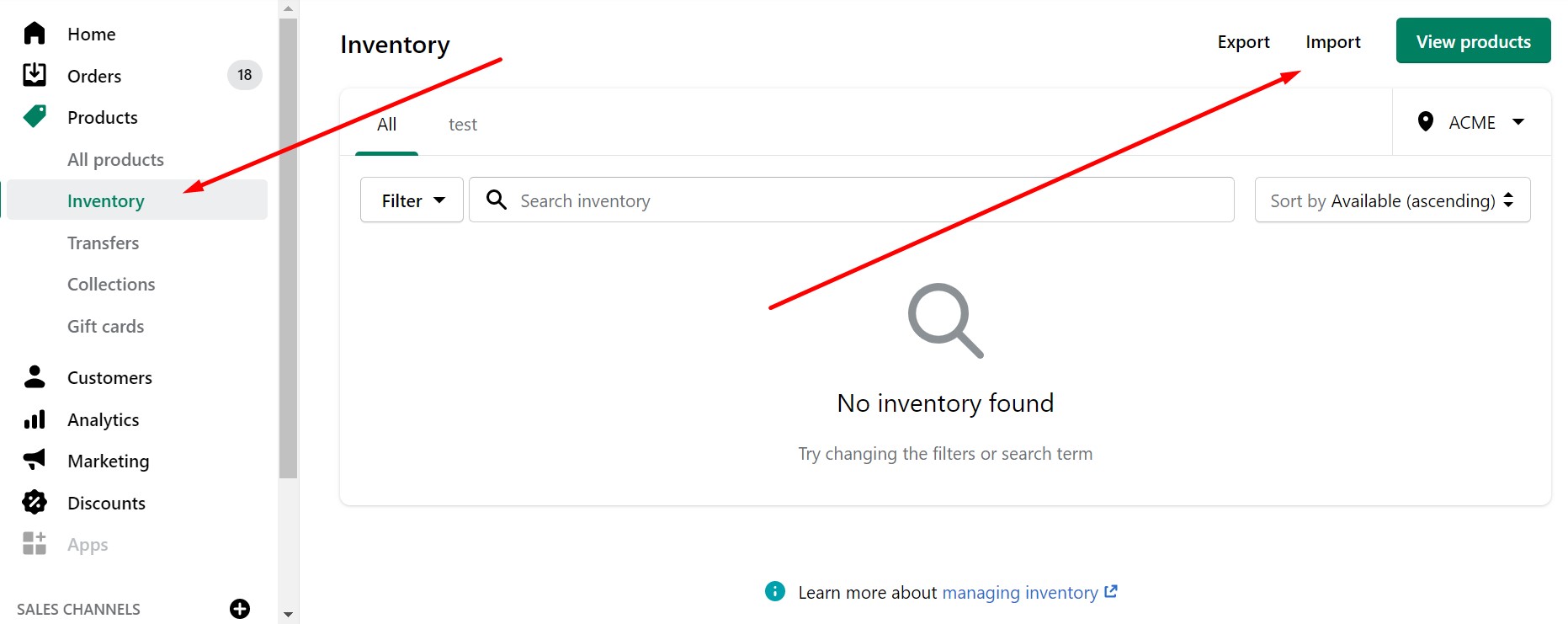
- Click Import and select your CSV file with the update.
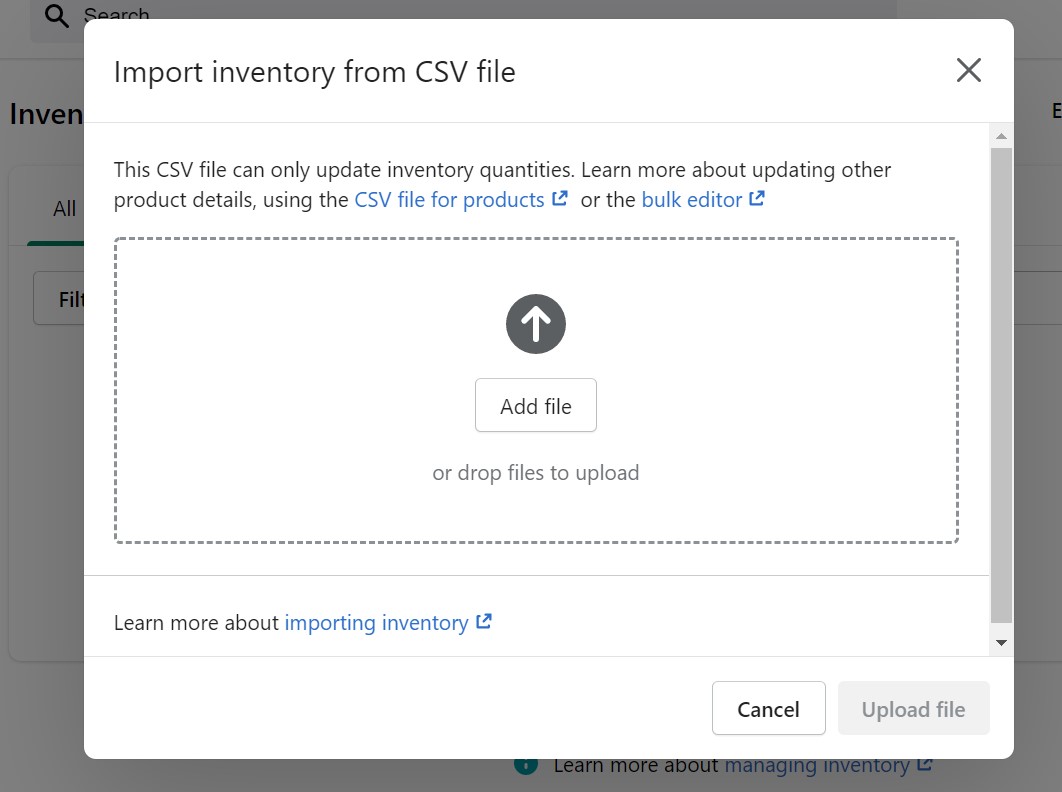
- Click Import inventory , verify what you intend to import, and hit the Outset import button.
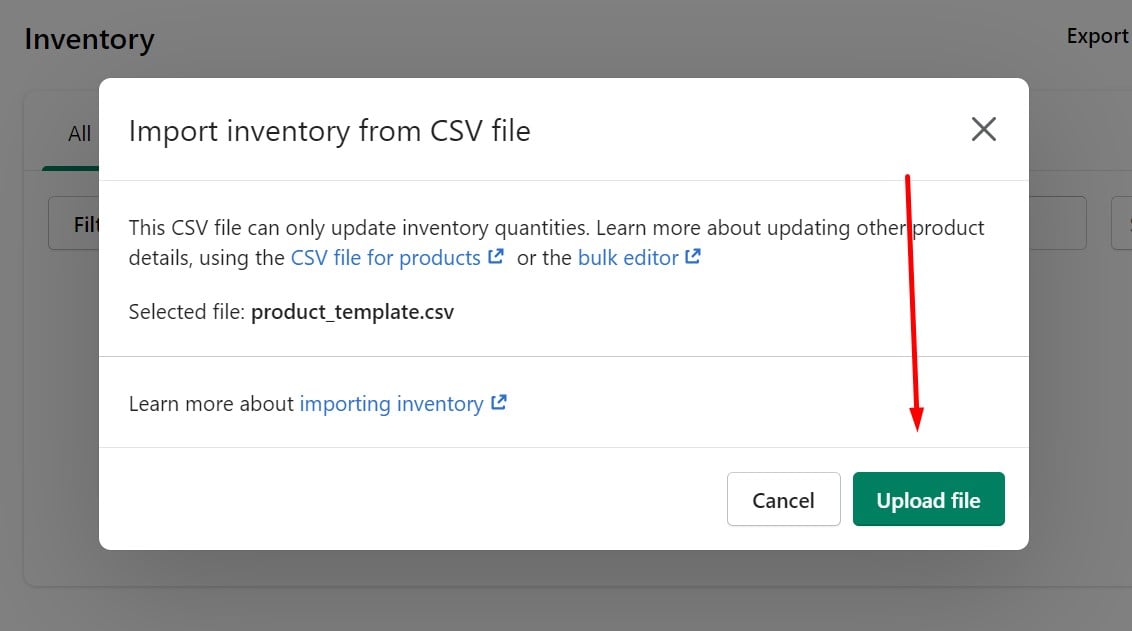
Shopify inventory import: CSV file format
Shopify uses the inventory CSV files to transfer data that identifies products and product variants as well as their inventory quantities at a particular location. The columns below are a function of the inventory sheet:
- Handle – here, Shopify displays a unique product proper noun using letters, dashes, and numbers. Note that spaces are prohibited.
- Title – this cavalcade is optional. However, including it lets you get out the values blank.
- Option1 Name – you lot can specify a product option proper name, such as Color, hither. Set it to Title for no options.
- Option1 Value – enter the values for the option above, such as Black or White. If a production has no options, specify Default Title in this column.
- Option2 Name , Option2 Value , Option3 Proper noun , and Option3 Value follow the aforementioned requirements just tin can be left bare.
- SKU – this column is optional, so its values tin exist left bare.
- HS Code – The Harmonized System Code column lets you estimate duties and taxes for international buyers. Since this cavalcade is as well optional, it can be left bare.
- COO – The Land/Region of Origin column also participates in estimating duties and taxes for international customers. Apply but . Since this cavalcade is optional, information technology tin can be left blank.
- <Proper name of location> – Shopify stores the amount of inventory in the location specified by the column name. Bear in mind that the column heading is example sensitive. Information technology means that it must be the proper name of one of your locations. Thus, yous tin can add a cavalcade for each location to update inventory per place. Both positive and negative values are supported. Besides, it is possible to enter 0 or Not stocked. The latter indicates that the product has never been stocked at the location. The quondam shows that no changes should be practical.
How to import customers to Shopify
Similar in the case of products, Shopify enables yous to import customers in two ways. Firstly, you can create a customer CSV template, export information technology, apply changes, and and so reimport the file back. Secondly, it is possible to build a custom CSV file and upload it to your Shopify website.
Note that the system constrains the customer import flexibility. Unfortunately, you cannot transfer CSV files larger than 1 MB. For 2 MB of client records, you volition need two separate CSV files.
Moreover, some of the customers' information can't be imported into Shopify. Since passwords are encrypted, you cannot move them from other platforms to Shopify. Information technology means that information technology is incommunicable to move customer accounts entirely. Shopify lets you transfer only customer records.
It is impossible to import information about orders placed and money spent on other e-commerce platforms. And so, how does Shopify behave when you try to import customers?
Equally we've simply mentioned, Shopify creates a client record when yous import customers using a CSV file. Each new record is aligned with a particular email address in the file.
Thus, if your CSV file contains customers with duplicate electronic mail addresses or telephone numbers, such records are skipped. Instead, Shopify transfers only the last record with the aforementioned email address or phone number. So, how to import a customer CSV file with duplicate email addresses or phone numbers to Shopify?
You can leverage a elementary pull a fast one on to do that. Just delete all of the email addresses and phone numbers from the CSV file before importing it. Thus, y'all will transfer all records to your website, manually re-adding the email addresses or phone numbers to the client records.
You can import customers to Shopify as follows:
- Go to the Shopify admin and click Customers .
- Cull the Import customers option.
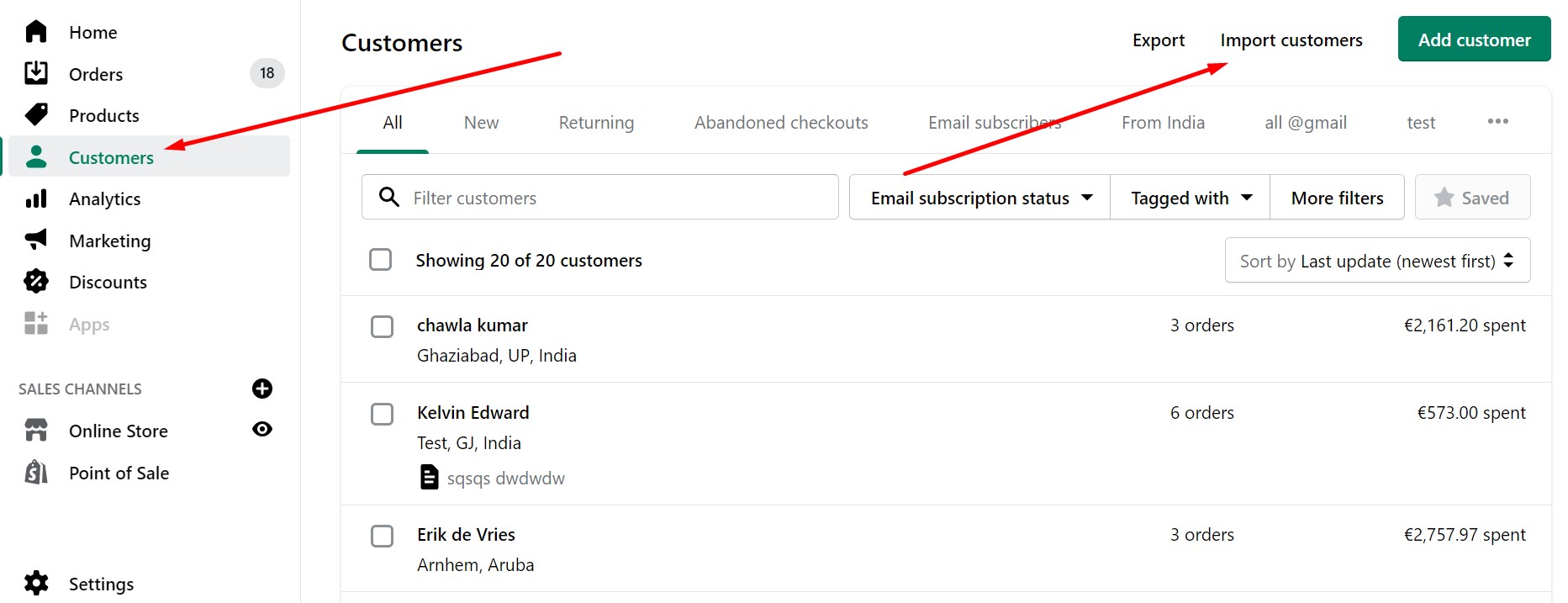
- Yous will actuate the Import Customers By CSV dialog where information technology is necessary to click Cull File and select your CSV with customer information.
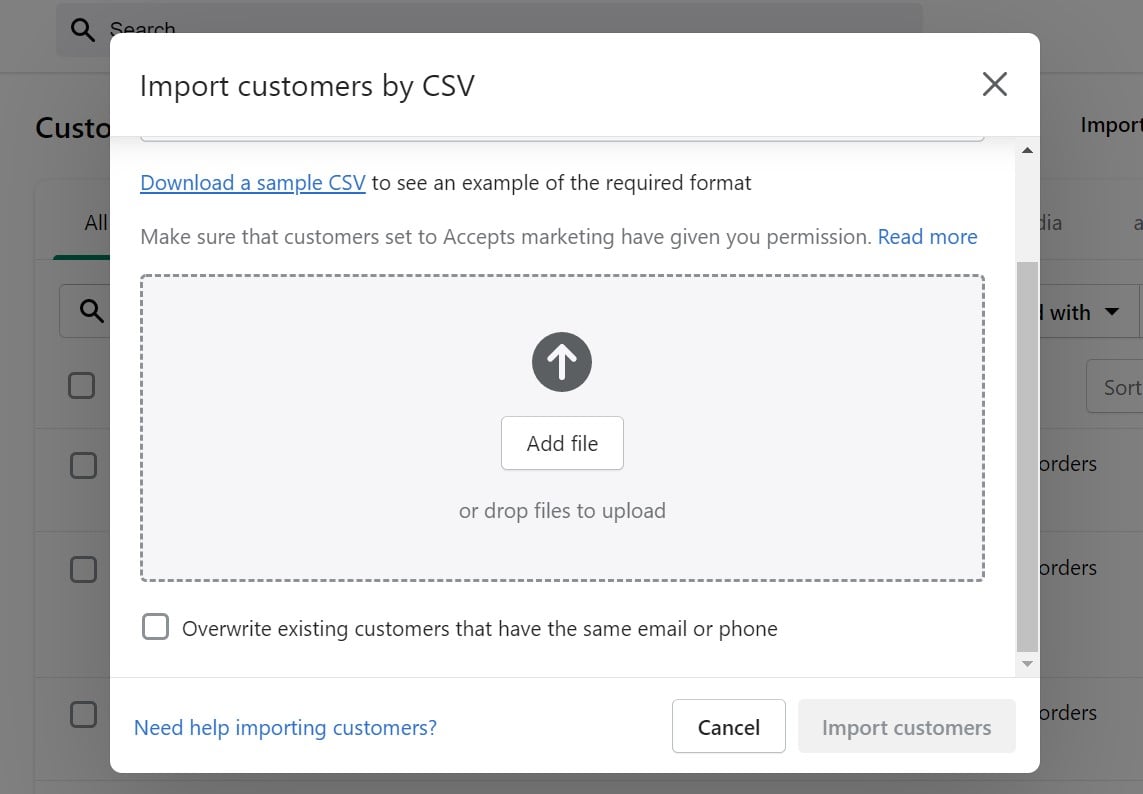
- Click the Overwrite existing customers that have the aforementioned electronic mail selection to update whatever existing customers.
- Hit the Import customers button to launch the procedure.
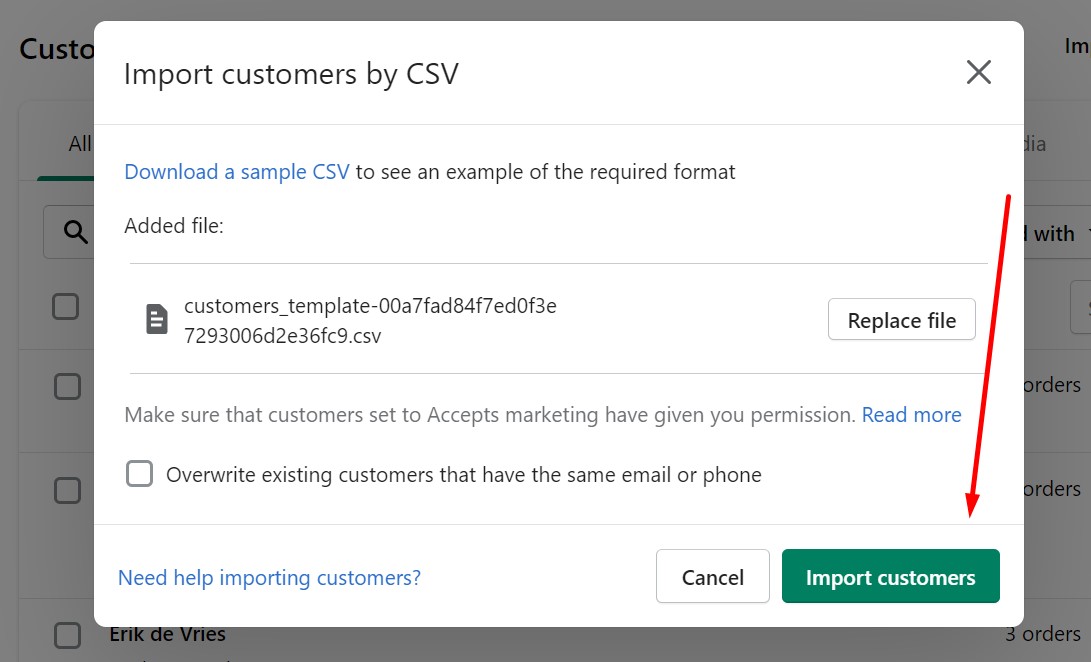
Shopify customer import: CSV file format
Add all the headers listed below to the first line of your customer CSV. All of them are included in the customer CSV template. As well, note that all CSV file headers are example sensitive. It means that yous should strictly follow the examples that appear in the following tabular array. The wrong capitalization may interrupt the Shopify import process.
And as we've just mentioned to a higher place, the Total Spent and Total Orders fields are non exist imported with customer details.
- Outset Name. The client's commencement name.
- Concluding Proper name. The client'southward last proper noun.
- Electronic mail. The customer'southward e-mail accost.
- Company. The customer'south company name, if applicable.
- Address1. The client's address outset line.
- Address2. The client's accost second line.
- City. The client'south metropolis they live in.
- Province. The customer's province or country they live in. It requires the Province Lawmaking .
- Province Code. Utilise only.
- Country. The customer'southward land they live in.
- Country Code. Specify here.
- Zip. The customer'southward postal or zip code for their accost.
- Phone. The client's contact number.
- Accepts Marketing. In this column, you tin can observe information on whether the customer is subscribed ( yes ) to the newsletter or not ( no ). Note that the field is case-sensitive, so you lot must apply only lowercase values.
- Total Spent. Here, you lot can discover the customer's total amount spent. Note that using a currency symbol is prohibited.
- Total Orders. This column contains data on the customer's total number of orders.
- Tags. Here, yous can run into a comma-separated list of tags associated with the client. Usually, they look as follows: tag1 , tag2 , tag3 .
- Note. Any additional data nearly the customer is specified hither.
- Tax Exempt. This column shows whether the customer is tax-exempt or not.
Note that your CSV file with customer data must exist in UTF-8 format.
How to import orders to Shopify
If y'all want to import orders to Shopify, you will face an obstacle that cannot be passed over. Importing this entity manually is impossible by default . Therefore, you need to find another way to transfer data unless you are a Shopify Plus user who has access to the Transporter app. Since the latter is available to a express group of users, nosotros'd like to draw your attention to a 3rd-party solution that every Shopify merchant can utilise.
Firebear Improved Import & Consign App for Shopify
You can dramatically meliorate all import processes on your Shopify website with the Firebear Improved Import & Export App. Our tool not just works with all the entities mentioned above but besides lets you transfer other blocks of information between your e-commerce storefront and any external systems.
Dissimilar the default import solution, our application provides full back up for products, inventory, orders, customers, and categories. Information technology also delivers the following functionalities:
- Import and consign mapping for all entities . It means that you can specify how to modify external data input to follow the native Shopify requirements.
- Support for CSV, Excel, and Google Sail . Our extension works non only with CSV files simply also with tables created in Excel. Also, you can import information right from Google Sheets.
- Flexible launch . You can not but run import and export jobs manually, like in the case of the native Shopify instruments, but too rely on schedules or events. For instance, you lot can start inventory updates daily or after a new society is placed.
- Custom import source and consign destinations . The Improved Import & Export Shopify app lets you upload data files direct to the system, import them from URL, or transfer via FTP/SFTP.
- Unequal merely import, update only . The tool lets you update stock data and other fields by production ID/SKU.
- Alter data on the wing . It is possible to use numerous changes before launching import and export. Our tool delivers the most intuitive fashion to change capitalization, find & replace attributes, use RegExp, merge and split values, etc.
You can discover more than data about the application here: Firebear Improved Import & Export App for Shopify . For further information on the enhanced Shopify import possibilities we offering, contact united states . We tin also help you lot with data transfers between Shopify and numerous external systems.
(Download for Free)
Shopify Import FAQ
Let'due south provide answers to several questions that are often asked well-nigh Shopify import.
Can I upload a CSV to Shopify?
With the native Shopify tools, you lot tin can merely apply CSV (comma-separated values) files to import products and other entities into your Shopify store. The same file format is available for information transfers from your due east-commerce website. If your import information is stored in another format, yous accept to convert the file into CSV. Alternatively, information technology is possible to apply third-party solutions that back up the provided format. For example, you tin can rely on the Improved Import & Export app for Shopify to extend the existing spectrum of supported information standards.
Can yous bulk upload products to Shopify?
Of course, you tin do that. The platform lets you lot bulk upload products, also equally other entities, to your e-commerce website with the help of a specially formatted spreadsheet. Equally nosotros've already mentioned, Shopify uses CSV files to perform this kind of bulk task. You can follow the recommendations posted higher up to run production, inventory, customer, and order import.
How do I import customers to Shopify?
Importing customers to Shopify is as piece of cake as transferring other entities to the platform. You just need to follow several manifestly steps.
– Get to your Shopify administration and click Customers.
– After that, striking the Import customers button.
– The organization transfers you to the Import Customers By CSV dialog.
– Y'all volition see the Choose file push button — click it and select your customer CSV file.
– Now, you accept to decide on the import beliefs. Shopify lets you update the existing customers with the assist of the Overwrite existing customers that have the same e-mail characteristic.
– If everything is ready, click Import customers.
How do I import items into Shopify?
You tin can import items to Shopify as follows:
– Go to your Shopify admin and continue to Products -> All products.
– Find the Import button and click information technology.
– The Import products past CSV file dialog displays — click Choose File here.
– Now, you need to locate your CSV file and open it.
– You tin can override the existing product data by activating the Replace any current products that have the same handle checkbox.
– When all other parameters are configured, click the Upload file push button.
How many products tin I upload to Shopify?
Shopify's default import and export tools are express when information technology comes to product import. Unfortunately, you cannot freely transfer more than 50k products to your e-commerce website unless you employ Shopify Plus. Once you hitting the 50k limit, the platform doesn't permit yous import more than 1,000 products per twenty-four hours. Luckily, there is no need to switch to the platform's more expensive version to exceed the limitation. Alternatively, you can rely on the Improved Import & Export app for Shopify since this tool doesn't impose constraints on the number of records in a CSV file. Therefore, you can import whatsoever number of products per twenty-four hour period.
How practise I import a product image into Shopify?
Shopify'southward bones product import procedure lets you upload product images to your e-commerce website. Use the Image Src column to specify the URL of a product image. The system downloads images during the import and uploads them back. Alternatively, you can transfer product images manually every bit follows:
– Move to your Shopify admin.
– Choose Settings.
– Proceed to Files.
– Select Upload files (superlative right corner).
– Now, upload image files from your device to your Shopify admin.
– Utilise these images to set upwards new products in your Shopify store.
Also, you can use the Improved Import & Export app to perform product import that transfers both product information and images.

southernpothead1969.blogspot.com
Source: https://firebearstudio.com/blog/the-ultimate-guide-to-shopify-import.html
Post a Comment for "What Happens to My Shopify Store After I Upload Acsv File"